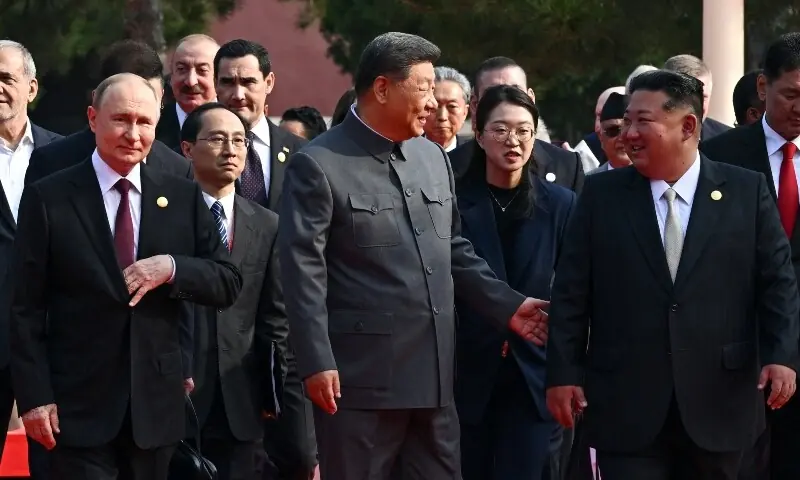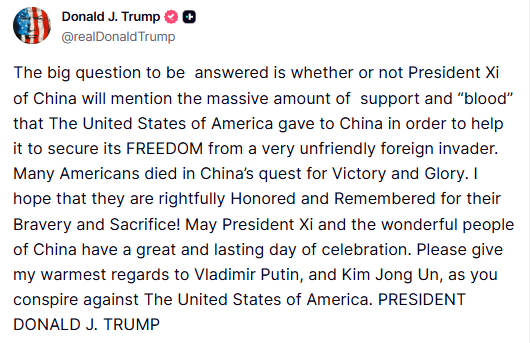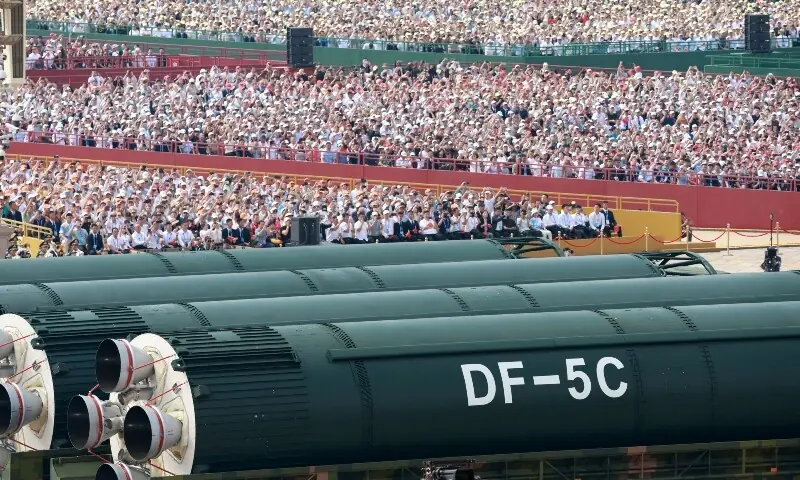North Korean leader Kim Jong Un, Russian President Vladimir Putin, and Prime Minister Shehbaz Sharif flanked Chinese President Xi Jinping at a massive parade of military might in Beijing on Wednesday, capping a week of diplomatic grandstanding by the Chinese president and his allies against the West.
The event, ostensibly to mark 80 years since the end of World War II, was a chance for Xi to put on an extravaganza to showcase China’s military prowess and bring together friendly leaders to send a message to the rest of the world.

Kicking off the parade, President Xi warned the world was still “faced with a choice of peace or war”, but said China was “unstoppable”.
China’s enormous new intercontinental ballistic missile DF-5C, with a range of 20,000 kilometres, counted prominently among the tonnes of hardware on display.
State-run Radio Pakistan reported that Indian Prime Minister Narendra Modi was “not invited to the parade” and that PM Shehbaz’s presence alongside Xi, Putin, and Kim highlighted Pakistan’s growing significance in the region.
The heavily choreographed event drew an acidic response from United States President Donald Trump, who accused the three leaders of plotting against the United States.
“Give my warmest regards to Vladimir Putin and Kim Jong Un, as you conspire against the United States of America,” he wrote on Truth Social.

Military hardware on show
During the 90-minute parade, Xi inspected the massed troops and weaponry from an open-topped limousine down Beijing’s vast Chang’an Avenue, before turning back to join his guests in a seating area above the iconic portrait of Mao Zedong on Tiananmen, the entrance gate of the historic Forbidden City.
China’s huge collection of military vehicles and heavy weapons rolled past the dignitaries, while images of thousands of servicemen and women in immaculate uniforms marching in tight ranks and soldiers jumping in and out of vehicles were shown in a slick state media broadcast.

Besides the ICBMs, new underwater drones and supersonic missiles were among the latest gear on display.
Beijing residents went out into the streets to catch a glimpse of a spectacular flypast involving scores of warplanes and helicopters, some making an “80” formation.
Millions of Chinese people were killed during a prolonged war with imperial Japan in the 1930s and 40s, which became part of a global conflict following Tokyo’s attack on Pearl Harbour in 1941.
Whirlwind week
All eyes were on how the trio of Xi, Putin and Kim — who rarely leaves secretive North Korea — interacted with each other, but the state media broadcast only offered rare snatches of the three together and foreign journalists were kept at a distance and told not to film or photograph the leaders.
The event was the climax of a whirlwind week for Xi, who hosted a slew of Eurasian leaders for a summit aimed at putting China front and centre of regional relations.
The club of 10 countries, named the Shanghai Cooperation Organisation (SCO), touts itself as a non-Western style of collaboration in the region and seeks to be an alternative to traditional alliances.
During the summit, Xi slammed “bullying behaviour” from certain countries — a veiled reference to the United States — while Putin defended Russia’s Ukraine offensive, blaming the West for triggering the conflict.
Many of the guests from the Tianjin gathering, including Putin, Belarusian President Alexander Lukashenko and several other leaders, joined Xi for the Beijing parade. However, no major Western dignitaries were among the two dozen world leaders at the event.
Political influence
Security around Beijing was tightened, with road closures, military personnel stationed on bridges and street corners, and miles upon miles of white barriers lining the capital’s wide boulevards.
China has touted the parade as a show of unity, and Kim’s attendance is the first time he has been seen with Xi and Putin at the same event. It is only his second reported trip abroad in six years.
Kim was accompanied on the trip by his daughter Kim Ju Ae, who was pictured arriving at Beijing Railway Station, and his sister Kim Yo Jong, who was photographed by AFP at a gala lunch.
Putin and Kim held talks after today’s parade, during which the Russian president thanked Kim for deployments of North Korean soldiers to aid Russia in its conflict with Ukraine.
Lam Peng Er, principal research fellow from the East Asian Institute at the National University of Singapore, said Kim’s visit “demonstrates to the North Koreans and the world that he has powerful Russian and Chinese friends who treat him with respect”.
“China also shows that it has convening power and political influence to bring Putin and Kim Jong Un together,” he told AFP.
from The Dawn News - Home https://ift.tt/so61pNQ
Comments
Post a Comment